Phoebe has done it! She’s officially a graduate! She passed the KUSA Canine Good Citizen Test with flying colours!
… and then the moment we’d all been waiting for happened! The judge formally walked over to me, shook my hand and said those magical words: “Congratulations. Phoebe is officially a Canine Good Citizen”.
You may remember in earlier posts that Phoebe and I have been preparing for her to take the Bronze Level Kennel Union of South Africa (KUSA) Canine Good Citizen Test. The preparations have been intensive, but we managed to have fun along the way. I also read the wonderful book Hell on 4 Paws where a behaviourist enrolls her dog for the test, and tried to study all the training and preparation techniques she used. In all honesty though, the more I read about the test, the harder it seemed to pass. I was worried this may be a goal too high for us at this point.
I had decided to enroll her to take the test, but so as to ease the pressure (on both of us!) I decided that failure IS an option, and that only participation and an overall ‘OK’ score would be enough to make me happy. We just needed some indicators of success, then I could always enroll her for the test again next year. And then she just shone on the day beyond my wildest expectations! She passed with flying colours!
Well Done Phoebe!
What is the KUSA Canine Good Citizen Test?
For those who aren’t familiar with this, it is an international standard test presented by Kennel Clubs to test if your dog can achieve the basic expectations of a ‘well-mannered’ dog. You can go here to read more about it.
So what exactly did the test entail?
We started the test by handing over our vaccination cards etc, and I had a nervous word with the tester to explain Phoebe’s history and her fear aggression/reactivity so that if anything did go wrong, at least she would be prepared and the situation would be controlled if Phoebe tried to snap at her dogs. The tester was a wonderful lady who put me at ease by asking more questions about Phoebe, and telling me to just relax as her dogs are very calm and used to being around all kinds of dogs. Her advice to me was that both Phoebe & I should just be calm and do the best that we can. And we did – with excellent results!
Here’s a summary of the test we did, with pictures of some of our fellow graduees
Test 1: Accepting a Stranger
This Test is to see that a stranger can approach the dog and handler in a casual, everyday situation. Ignoring the dog the Evaluator will walk up to the handler and greet him in a friendly way and shake hands. The dog must show no signs of resentment or shyness and must not leave his position to go to the stranger. Sitting politely for petting by a friendly stranger, with the dog sitting at the handler’s side, the Evaluator pats the dog only on the head and body, and then circles the dog and handler which completes the Test. The dog must not show shyness or resentment.
Test 2: Putting on a Collar and Lead
The dog should have a well-fitting buckle or slip collar of leather, fabric or chain. Special collars such as “pinch” or “spike” collars are not permitted. The lead must be either leather or fabric.
Test 3: Presenting for Examination.
The purpose of this Test is to see if the dog can be examined by a Judge or a Vet without it becoming aggressive or flinching. On a lead the handler will present the dog to the Evaluator for a gentle examination of its mouth, teeth, throat, eyes, ears and feet.
Test 4: Grooming
The Evaluator will inspect the dog to see if it appears healthy, is clean and groomed and will permit a stranger such as a vet or groomer to examine it. The Evaluator then combs or brushes the dog and lightly examines the ears and front of each foot to see if it will accept grooming from someone other than its owner
Test 5: Praise and Presentation
The Test is to demonstrate that a dog can be calmed easily following praise or play and can leave the Test in a well mannered fashion. The handler may praise the dog verbally, by petting, by playing with a toy and/or via a favourite trick, in the allowed ten (10) seconds of play and then must calm the dog for the next test.
Test 6: Release from Lead, Play, Recall and reattach to Lead
The purpose of this Test is to see if a dog can play happily off lead and be recalled and be put back on lead. The handler will release the dog from the lead and either play with it or throw some object for it to fetch and play with, then recall the dog and place back on lead.
Test 7: Walking on a Loose Lead
The purpose of this Test is to demonstrate that the handler is in control. The dog must be on the left side of the handler but need not be in the “heel” position. There should be no doubt that the dog’s attention is on the handler and it responds to movements and changes of direction. The course taken must include a left turn, right turn, an about turn, a stop in between and at the end of the Test.
Test 8: Pass Through a Door /Gate, on Lead
The dog should walk confidently through the door/gate and should not shy away from it.
Test 9: Walk on Lead passing People
This Test is to demonstrate that the dog should have no difficulty in walking through pedestrian traffic. The dog should walk around close to at least four (4) persons one of whom should have a dog. The dog may show interest in the strangers and the dog, but should continue to walk without any evidence of shyness or over exuberance and should not be pulling at the lead. Throughout this Test the handler may encourage, praise or talk to the dog.
Test 10: Reaction to an Unfamiliar Dog
This Test is to demonstrate the proper behaviour in the presence of other dogs. Starting at a distance of ten (10) metres from each other, two handlers walk towards each other, meet, stop, shake hands, exchange a few words and continue for about five (5) metres. The dogs should demonstrate only casual interest. Neither dog should go to the other dog or handler.
Test 11: Stay to Command
This Test is to demonstrate that the dog has some training and will respond to the handler’s commands. Taking reasonable time, the handler commands the dog first to “sit” and then to “lie down”, using as many commands as he likes. He must not force the dog into position. The “stay” command is then given and the handler walks about seven (7) metres from the dog and returns at a natural walking pace to the dog, which must maintain its position until the handler returns and the Evaluator gives permission for the dog to move.
Test 12: Reaction to Distractions
This Test is to demonstrate the dog is confident at all times when facing a distraction. The Evaluator must select two (2) of the following for this Test (they need not be the same for each dog).
- Simulation of a handicapped person with crutches, a walker or a wheelchair
- Sudden opening or closing of a door or solid gate.
- Dropping a large book or similar object behind the dog but no closer than three (3) metres.
- A jogger passing in front of the dog.
- Someone pushing a pram, or shopping cart from the front or rear and passing within two (2) metres of the dog and handler.
- A cyclist passing in front or from the rear within two (2) metres of the dog and handler.
- The dog may express natural curiosity and interest and may startle, but should not panic, try to run away, show aggressiveness or bark.
Test 13: Supervised Isolation
This Test is to demonstrate a dog can be left alone if necessary, whilst maintaining its training and good manners. Evaluators are encouraged to say something like “would you like me to watch your dog while you make your call?”, both to add a touch of reality and to accentuate the fact that leaving a dog tied up and unsupervised is not condoned. The dog will be attached to a two (2) metre line. It does not have to stay in position but should not continually bark, whine, howl, pace unnecessarily or show any behaviour with a mild agitation or nervousness.
—
After the test Phoebe and I hid around the corner so that we didn’t interfere with the Beagle in class who gets very anxious when he sees Phoebe (he just doesn’t understand why she won’t play with him!). I watched the rest of the class with just as much anxiety and nervousness that I had for Phoebe – we were all in this together, and all worked hard to get through this!
Once everyone had completed their turns the judge put her dogs to sleep in their mobile tent and she diligently filled out all the forms. We were a wreck while we waited with baited breath to hear the results!
… and then the moment we’d all been waiting for happened! The judge formally walked over to me, shook my hand and said those magical words: “Congratulations. Phoebe is officially a Canine Good Citizen”.
The great thing about this moment was the way our Behaviourist and the rest of the class cheered, clapped and congratulated Phoebe and I. There were tears of happiness all round (though Phoebe was a bit confused at all the hullaballoo!). I had no idea that this team of people I trained with, and often felt so guilty about when Phoebe reacted to their dogs had invested so much concern for her to achieve. It was a moment I’ll never forget.
Do you recommend the Canine Good Citizen to others?
A resounding YES! Not only for the sense of achievement that you and your dog feel when you’ve successfully achieved it, but the practical implications of having the certification are innumerable, especially for a dog like Phoebe who has a troubled past, is reactive, has separation anxiety, and can sometimes be seen as a “nuisance” to others who don’t fully understand the long healing process. Now if I have any problems with complaining neighbours, or inconsiderate fellow dog park walkers I have the comfort of knowing not only that I actually can control my dog, but that I also have physical, hardcopy proof of all the work being put into her. Aint nobody gonna criticise Phoebe, or me now! 🙂
The preparation for the test is also great because it gives you ‘direction’ for focus and training exercises, while also forcing you to get out there and take those walks and exercises when you otherwise might not because of miserable weather etc. Even if we pulled out of the test itself, just that part of it made it all worth the effort!
Will there be more?
We’ve discussed preparing for the Silver Level KUSA Canine Good Citizen Test, but for now I think it may be too fast, too soon. There’s a lot more off leash interaction with other dogs, and though Phoebe has been great, I don’t want to push her too far over her threshold limit and undo the good work we’ve done by putting her in uncomfortable situations. But who knows? With the rapid progress she’s made over the past year, she may just overshoot any and all expectations once again!
—
Phoebe’s Effectiveness Summary:
Issue Addressed: Obedience, Focus
Tool(s) Used: Obedience Training and Behavioural Training
Cost: Moderate
Ease of Implementation: Moderate
Phoebe’s Effectiveness Rating: 5/5. Phoebe loves attending her classes, and through these guided lessons we both learn new coping methods and ways to have fun. Preparing for the Canine Good Citizen Test was sometimes difficult and stressful, but ultimately fun and rewarding for us both. Phoebe loves to play and get rewards for hard work so we’ll definitely carry on attending classes irrespective of whether we try for further qualifications.
—-
What do you think? Have you considered the Canine Good Citizen Test? How do you think your dog would do?

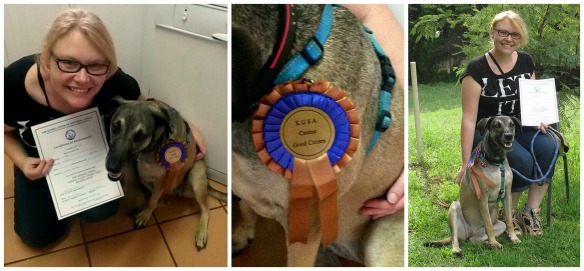
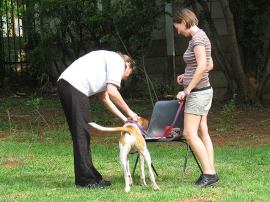

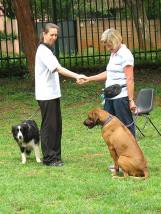
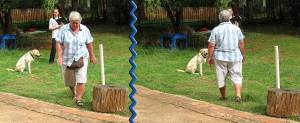
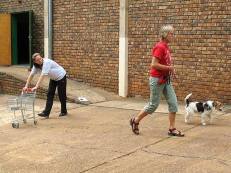

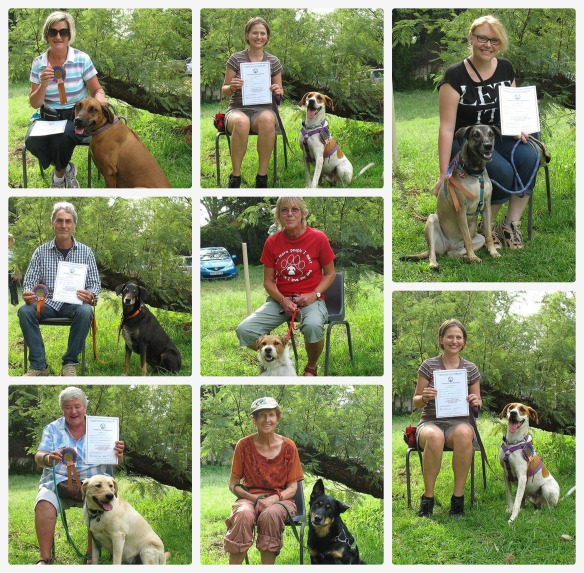
I’ve just found your blog, and am still making my way through your previous entries, but just had to say a big congratulations to you and Phoebe for getting your CGC!
It’s a dream of mine to get one with my reactive GSD, something I’m not sure we will ever accomplish, but something to work towards anyway 🙂
LikeLike
Hi there! Thanks for the congratulations, Phoebe and I have worked so hard to get to this point and I’m so proud of her! Don’t get discouraged with your shepherd, it’s a looong process but really worth it when you begin to see the results. We still have lots of work ahead of us, but I know we’ll get there one day.
My best advice would be to be patient, not get discouraged and consider enlisting the help of a good positive-training based Behaviourist in your area. Good luck and feel free to pop in again and let me know how it’s going with you guys!
LikeLike
What a great post! I hope that eventually my two dogs are able to accomplish what your lovely Phoebe did. No doubt it will be a challenge. Thanks for your great detailed post and for stopping by my blog, too.
LikeLike
Thanks for stopping by! I’m sure your beauties will pass the test without any problems, and going on to become a therapy dog is such a wonderful goal. Wishing you all the best of luck!
LikeLike
Pingback: Phoebe Silver CGC | The Dogtails
Pingback: Phoebe passes the Silver CGC Test! | The Dogtails
Pingback: What is the Canine Good Citizen Test? | The Dogtails